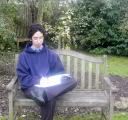Master 236: Ann & Voskamp, Part 2
--
In Spring, ____, Artemis Industries appointed Dr. _____ Voskamp to the position of project director of its lunar biosphere and terraforming project. His installment was not uncontroversial. His reclusive and misanthropic tendencies were widely known and promised to pose significant public relations, as well as internal human resources, problems. But his credentials in bio-engineering and xeno-ecology were unmatched, and it was hoped that his expertise would place the project, already suffering from three significant set-backs, back on track. Unfortunately, the exact opposite occurred.
Three months after his appointment, during his first visit to the biosphere project site, a code three disaster alert was issued: mandatory evacuation. Two scientists from that project site, three researchers from two other science stations, and seven guests and staff from the Astral Hotel and Landing Station (the only commercial lunar project) blasted into space within eleven minutes. Dr. Voskamp, alone, remained unaccounted for.
The two scientists from the biosphere reported that one of the containment units in laboratory number two, where Dr. Voskamp was working, had ruptured, releasing spores from bio-engineered plants into the ventilation system. A satisfactory account of the containment failure has never been given. Because of the nature of the disaster, the twelve evacuees were denied permission to reenter terran air-space until any biological threats could be assessed. Within 36 hours, the two scientists from the biosphere site showed signs of massive infection and mutagenesis. Both died within the week. The remaining ten never showed symptoms but were quarantined on an orbital space platform for six months before finally being allowed to return to earth.
The International Space Cooperative established a containment zone around the biosphere--forbidding all persons, under any circumstances, from moving within two hundred miles of the site. Five robotic probes were released in succession to study the biosphere and its environs, but each mission was aborted due to mechanical failure. No adequate explanation of these failures has been found, and further investigation has been discouraged by worries about contamination. Satellite photography showed signs of explosive vegetative growth within the biosphere in the months following the disaster, but the Cooperative determined that the biosphere was intact and that there was no immediate danger of outside contamination.
In the weeks immediately following the disaster, there was widespread speculation about the fate of Dr. Voskamp and any connection that he might have had to the biosphere disaster. But after a year, only those on the fringe continued to seriously consider the possibility that he was alive and was responsible for frustrating the Cooperative's efforts to gather more data about the biosphere.
Moon-based research and commercial ventures dropped off for about a decade after the disaster, but now, fifteen years later, there are seven active research stations and two commercial projects being developed on the moon.
Our story opens on a view of a small ship reentering earth's atmosphere--a converted two-person military space plane. This model was retired from official service twenty years ago. And this particular plane shows marked signs of wear. At the controls sits a white-haired, white-mustached, balding, middle-aged man, wearing a space suit that looks like it ought to have been retired forty years ago. Behind him sits a young woman, his only daughter, Ann. …
--



--
God is in this place,
And that reality, seen and understood by the grace of God in Christ Jesus through the work of the Holy Spirit, makes all the difference in the world.


0 Comments:
Post a Comment
<< Home